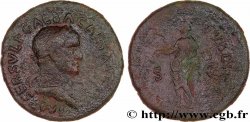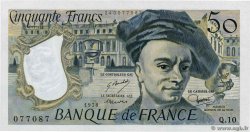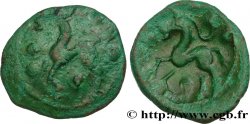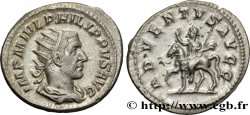v16_0496 - GALBA Tétradrachme syro-phénicien
MONNAIES 16 (2002)
Startpreis : 130.00 €
Schätzung : 220.00 €
Erzielter Preis : 130.00 €
Anzahl der Gebote : 1
Höchstgebot : 130.00 €
Startpreis : 130.00 €
Schätzung : 220.00 €
Erzielter Preis : 130.00 €
Anzahl der Gebote : 1
Höchstgebot : 130.00 €
Type : Tétradrachme syro-phénicien
Datum: an 2
Name der Münzstätte / Stadt : Antioche, Syrie, Séleucie et Piérie
Metall : Silber
Durchmesser : 27 mm
Stempelstellung : 12 h.
Gewicht : 14,49 g.
Seltenheitsgrad : R1
Kommentare zum Erhaltungszustand:
Beau portrait. Légèrement décentré au droit. Exemplaire convenable pour ce type
N° im Nachschlagewerk :
Pedigree :
Cet exemplaire est le 0100_010 de la base TSP
Vorderseite
Beschreibung Vorderseite Tête nue de Galba à droite (O°).
Legende des Averses [AUTOKRATWR] GALBA KAISAR SEBASTOS
Übersetzung der Vorderseite (L'empereur Galba césar auguste).
Rückseite
Beschreibung Rückseite Aigle debout à gauche sur une couronne, les ailes déployées, tenant une couronne dans son bec ; devant dans le champ à gauche, une palme verticale.
Legende des Reverses : ETOUS B
Übersetzung der Rückseite (an 2).
Kommentare
Le style hellénistique de ce portrait très particulier montre à cette époque la présence en Orient d'une véritable école de gravure, très différente de celle de Rome. La légende grecque porte en revanche des traces de romanisation avec l’abandon du sigma pour le C majuscule et du Pi pour une P, lettres que nous n’avons pu reproduire dans la légende, faute de caractères spéciaux. Les auteurs du RPC ont répertorié 32 exemplaires. Pour notre type avec 17 tétradrachmes, nous avons 7 coins de droit.
The Hellenistic style of this very particular portrait shows the presence in the Orient at this time of a true school of engraving, very different from that of Rome. The Greek legend, however, bears traces of Romanization with the abandonment of the sigma for the capital C and of Pi for a P, letters that we have not been able to reproduce in the legend, due to a lack of special characters. The authors of the RPC have listed 32 examples. For our type with 17 tetradrachms, we have 7 obverse dies
The Hellenistic style of this very particular portrait shows the presence in the Orient at this time of a true school of engraving, very different from that of Rome. The Greek legend, however, bears traces of Romanization with the abandonment of the sigma for the capital C and of Pi for a P, letters that we have not been able to reproduce in the legend, due to a lack of special characters. The authors of the RPC have listed 32 examples. For our type with 17 tetradrachms, we have 7 obverse dies








 Berichten über einen Fehler
Berichten über einen Fehler Die Seite drucken
Die Seite drucken Teilen meiner Auswahl
Teilen meiner Auswahl Stellen Sie eine Frage
Stellen Sie eine Frage Einlieferung/Verkauf
Einlieferung/Verkauf
 Details
Details















